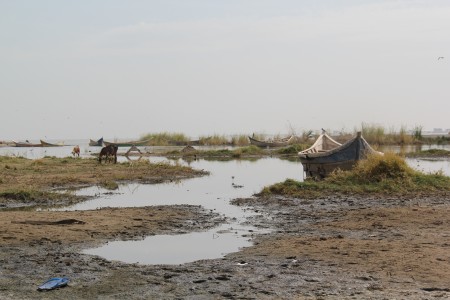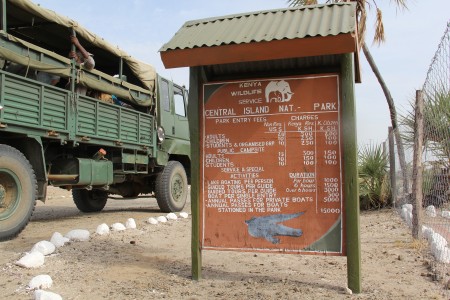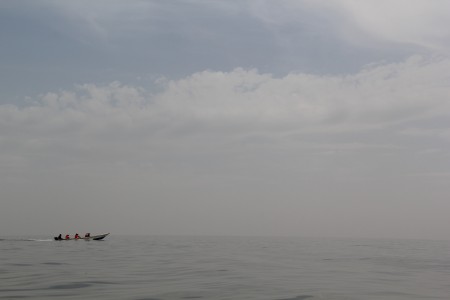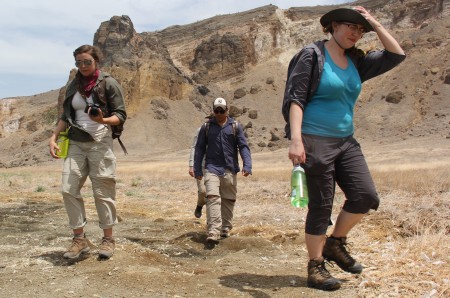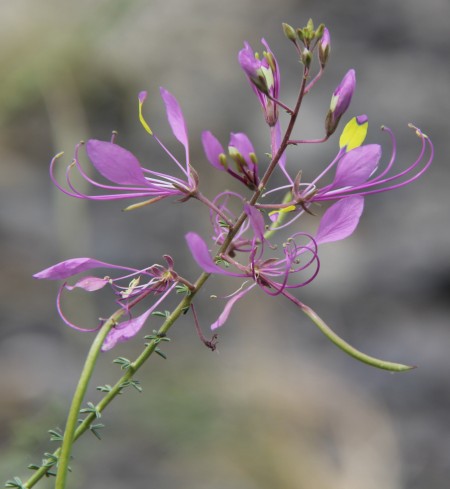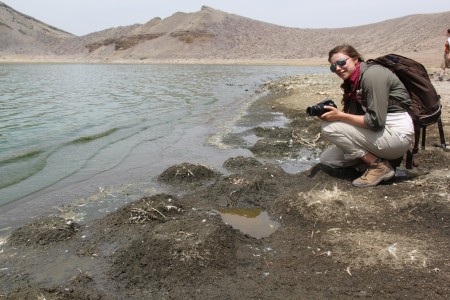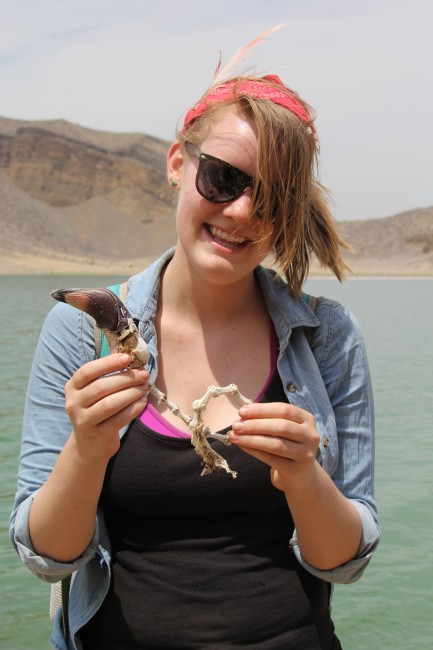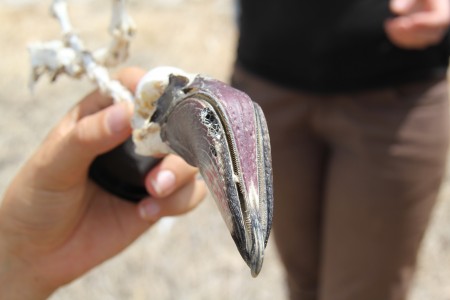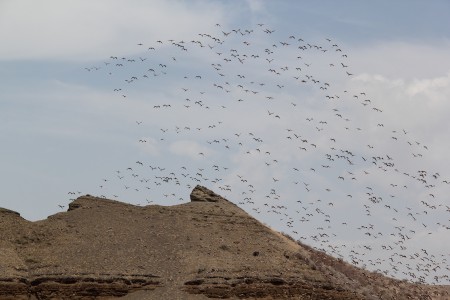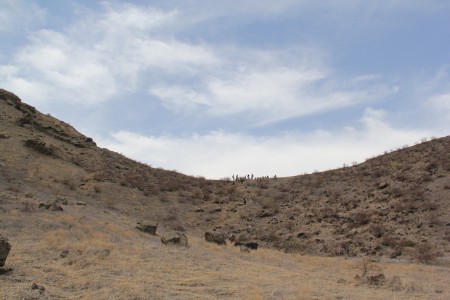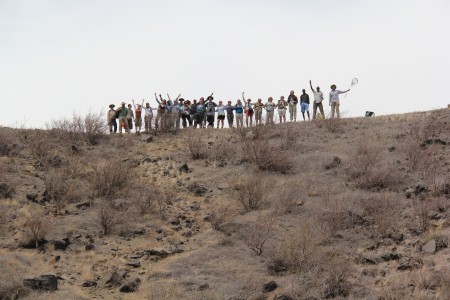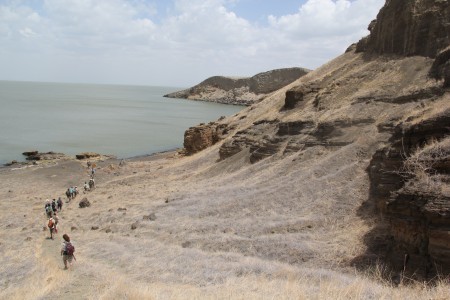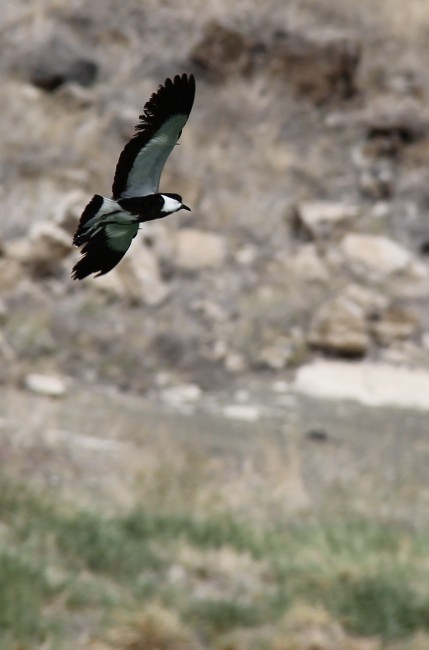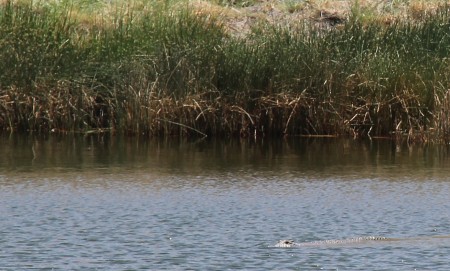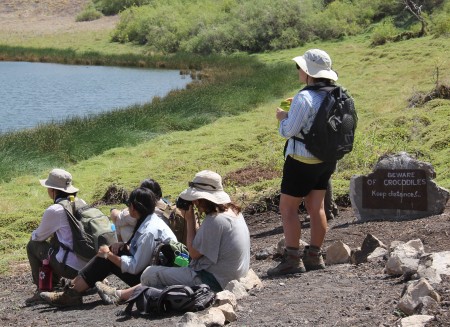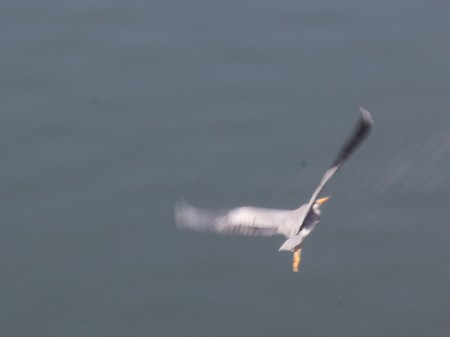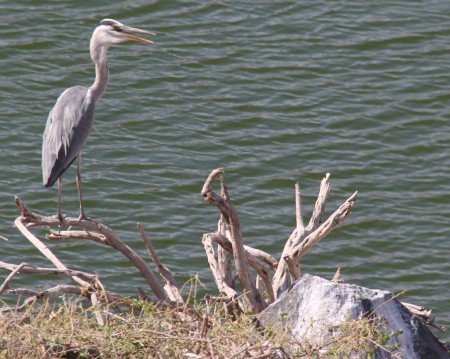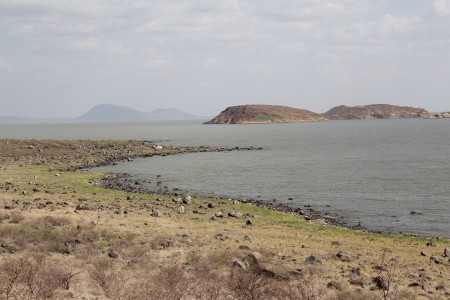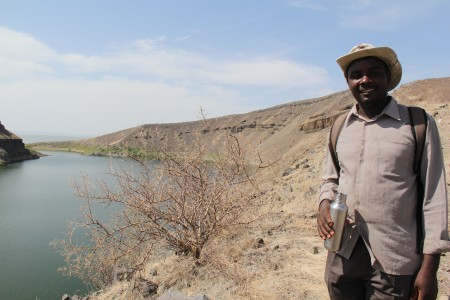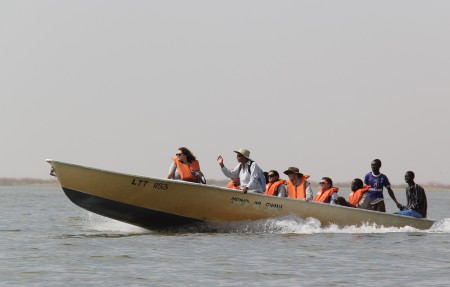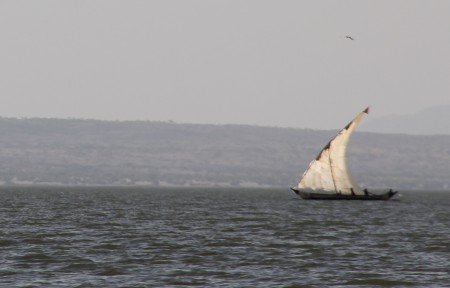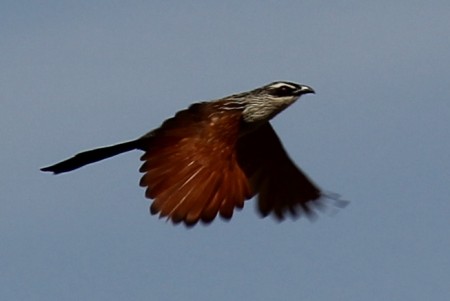In the middle of Lake Turkana, an experiment is taking place without a single person touching a pipette or checking their controls. The open-air lab is called Central Island, and few people have had the opportunity to watch the experiment in action.
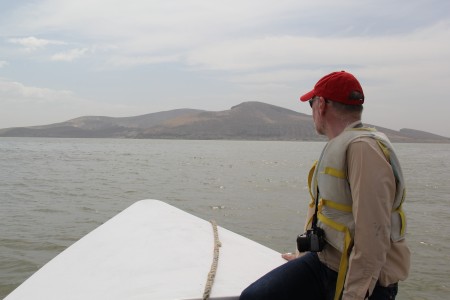
Dr. Craig Feibel, professor of geology at Rutgers University, approaches Central Island, a geologically recent addition to Lake Turkana's landscape.
A few thousand years ago, an explosive volcano busted through the waters of Lake Turkana, another product of East Africa’s failed attempt to escape the African continent. Rather than forming an expansive shield volcano similar the Hawaiian Islands where flowing lava piled up to form landmasses, Central Island unleashed sudden, violent explosions of ash and blobs of slowly crystallizing melt. Instead of forming a single cone, the island formed multiple craters as each explosion vented through different cracks in the thin surface over the Central Island magma chamber.
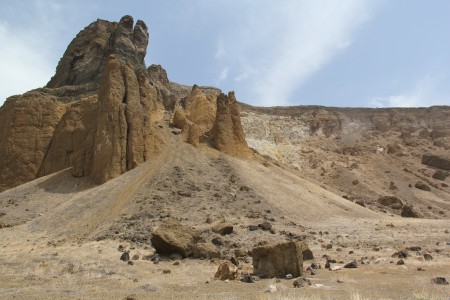
Layers of ash and lava bombs have piled up along the edges of the craters, laying down the stratigraphic story of the island.
The ash and crystallizing basalt piled up to form steep cliffs and ridges and the craters filled with water, forming large isolated lakes. Today, three large lakes dot the island: Flamingo Lake, Crocodile Lake, and Tilapia Lake. As their names imply, each lake has a different community of associated animals along with different sizes and chemistry.
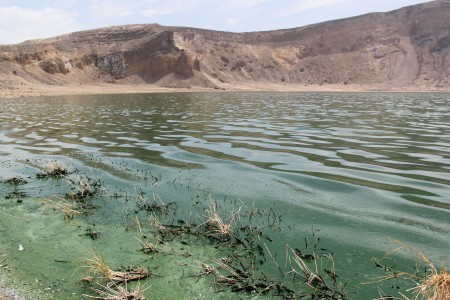
The shores of Flamingo Lake on Central Island are ringed with vivid green algae, life support to invertebrate on the wing and in the water.
Central Island is a natural experiment in niche partitioning and morphological adaptation in a changing geological context with geology affecting biology and biology affecting geology right back. Fortunately we had experts in both fields along for our visit to Central Island National Park.
Dr. Dino Martins was with the field school on his last full day at TBI to discuss the special ecology of Central Island while Dr. Craig Feibel joined us for his first full day in Turkana to describe the geological events that led to the surreal landscape. Just one of these experts leading an excursion to Central Island would have been an incredible opportunity, but a tour with both could not be missed.
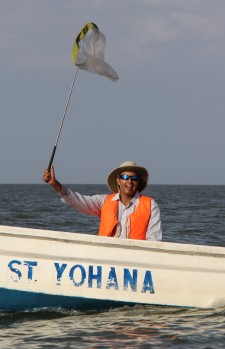
Dr. Dino Martins on his final day with the Spring 2013 Field School reminding us there are interesting insects everywhere just waiting to be scooped up.
The voyage to Central Island was not a simple stroll to the coast. It involved a long, dusty ride in the back of the field truck to the fishing town of Kalakol on the shores of Lake Turkana, followed by a motorboat ride across the lake. In case your image of a lake is a relatively placid body of freshwater, know that we nearly canceled the trip a few days earlier due to large swells that may have capsized our boats. Fortunately, we couldn’t have asked for a better day to motor across the Jade Sea, the nickname Lake Turkana earned with its abundant algal content.
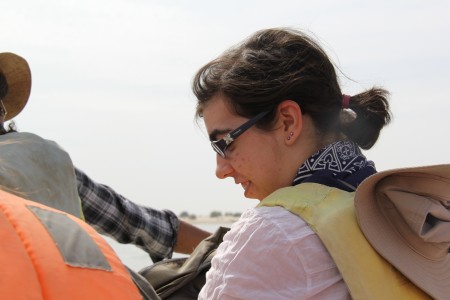
Ashley, aspiring marine archaeologist, was happy to get some time away from the sand and onto a boat, a key desire for anyone interested in digging for artifacts at the bottom of the ocean.
Central Island loomed on the hazy horizon; its cratered profile shielding the lakes and biodiversity from prying eyes.
We arrived on a black sand beach, evidence of recent volcanic activity surrounding our feet as pumice pebbles floating in the surf. The sheer cliffs were composed of precariously balanced ash filled with large basalt clasts. The cobbles once sat deep below our feet, crystallizing and solidifying before the pressure below overcame the pressure from above, and the partially solidified material flew out along with the dust-like ash.
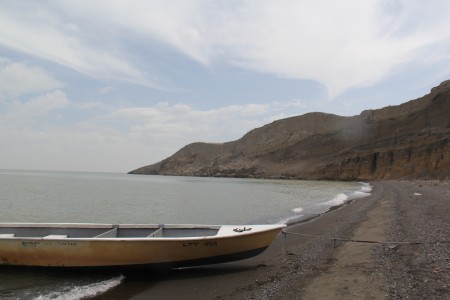
The black sand along the shores of Central island comes from the volcanic basalts that have been thrown out by the volcano slowly breaking down. Pumice, volcanic rock so porous it can float, bobbed along in the surf.
A footpath led up the side of the crater. Peeking over the edge we saw one of the brooding volcano’s craters below, now a perfectly circular lake ringed with brown grass, green algae, and a thin varnish of pink from the massive flock of flamingos that call the crater home.
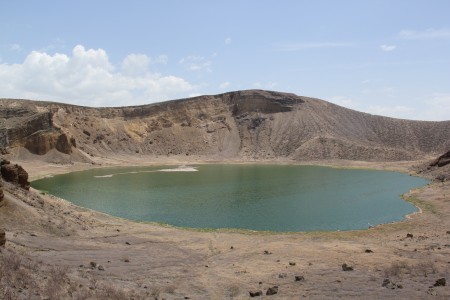
After a scramble up the ashy slopes of the Flamingo Lake crater, we finally got to see what all the ecological and geological fuss was about. Note the flock of flamingos on the left side of the lake making a giant flamingo.
Descending the crater’s interior, the flamingos took off, a riot of pink, coral red, and black to find a more secluded part of the lake. As we hiked around the lake, examining the mud-pile flamingo nests, the flowers blooming in the rich volcanic soil, and the sulfur vents letting off subterranean steam, the flamingos continued their search for privacy. The flock exploded upward every time we drew near, a squawking parody of the eruptions that formed the caldera.
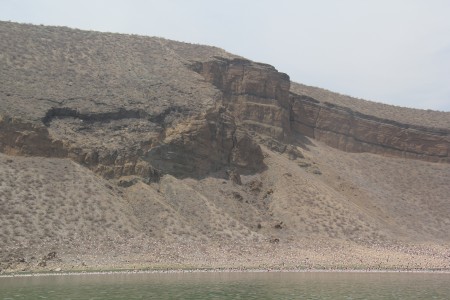
The flock of flamingos takes off in a low formation, paralleling the horizontal stratigraphy of the crater.
The flamingos call the lake home because the secluded, salty water is the ideal environment for the tiny invertebrates the flamingos filter for dinner. Flamingos are among the more absurd birds, as lawn ornament peddlers, Lewis Carroll, and Disney have pointed out. But their goofy morphology is actually perfectly adapted to their salt-water lifestyle. Standing on their spindly legs high above the water, they dip their Roman-nosed beaks perpendicular to the water’s surface. The edges of the beak are lined with small tines that filter food from the water as they pump their tongues, slurping up their miniscule prey without moving from their balanced posture. An incredible adaptation. Still absurd.
We piled back into the boats and moved around Central Island to reach Crocodile Lake. As we approached the shore, a variety of birds including ibises, herons, egrets, and geese revealed the less-extreme chemical composition of this lake, a fusion of two currently quiet craters with a greater biodiversity than Flamingo Lake.
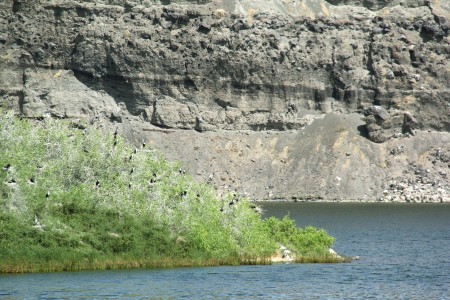
A flock of cormorants roosting close to the shores of Crocodile Lake, out of reach of the crocs, but unfortunately far enough from the reach of egg poachers.
The path brought us to a low ridge above the lake where the eponymous reptiles could be seen below, slowly swinging their tails through the water. The sign warned us to be cautious near the water’s edge. We didn’t need to be told twice, especially when a behemoth surfaced and cruised near a worried-looking Goliath heron.
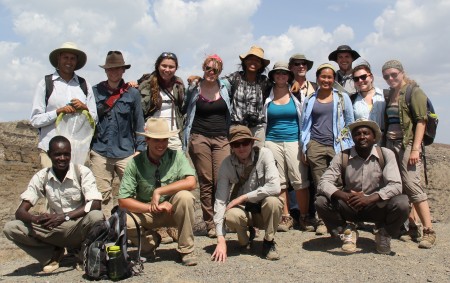
The slightly crazy group that decided to spend more time in the sun high above a crocodile infested lake. (Back: Dr. Dino Martins, Matt, Cory, Natalie, Ana, Sam, Dr. Craig Feibel, Holly, John, Leanna, Ingrid. Front: Francis, Tim, Marcel, Francis)
We hiked up the steep trail around the lake’s rim to get a bird’s eye view of the water. A large, rare terrapin surfaced and dove as birds wheeled over the water’s surface. Suddenly an explosion of feathers and water disturbed the quiet lake. As the large ripples dissipated outwards, we could see a grey heron who had been swooping near the lake’s surface in search of fish in the jaws of a large, hungry croc. Nature red in tooth and claw.

Unfortunately for the grey heron, he found good hunting grounds for heron. (Sorry the image is blurry. It's zoomed in without a tripod. The croc's head is the grey-green wedge just right of center. The heron's head is the white triangle right of the crocodile's snout. The crocodile is clamped down on the heron's neck with the bird's left wing going under the croc's jaw.)
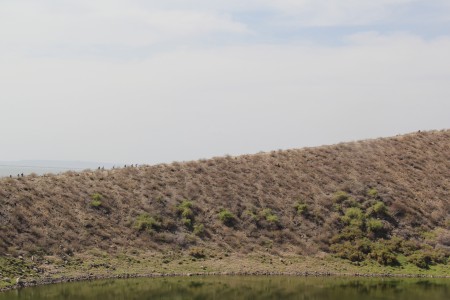
Hiking back along the crater's edge (tiny figures left of center). The crater forming Crocodile Lake supported a lot more vegetation than the Flamingo Lake crater which is only a few hundred meters away. Such variability in such a short distance makes Central Island a biological and geological mecca.
Back to the boats and the trip home across the desert. But first we had to get off the island, a step made more complicated by one boat’s motor refusing to turn over. The boat’s owner, a bishop in full garb, wasn’t able to get the propeller spinning again so he decided to rope the boats together to tow us through the rolling waves. He didn’t suggest prayer, but I thought it might be more reliable than the flimsy rope. Fortunately, he knew his trade and his boat, and we all made it back to shore without further incident.
The long ride home was lit by a brilliant sunset and the day on the Island ended with a flashlight-lit river crossing through the Turkwel and back to TBI, a final dose of soggy adventure after a day of exploration. A day spent clamoring through ecological and geological mysteries of Lake Turkana was the perfect transition to the next two weeks which we will spend learning about the foundations of the Turkana Basin with geologist Dr. Craig Feibel. To the rocks!

